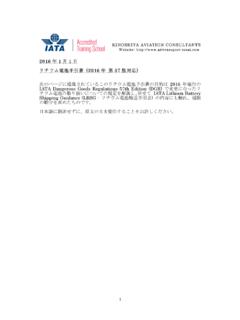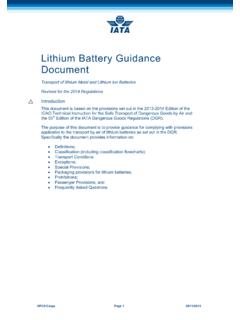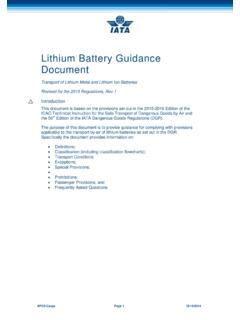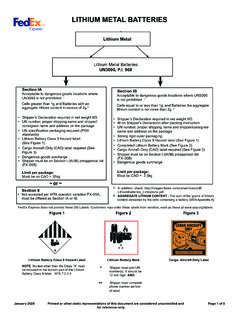Transcription of Safety Issues for Lithium-Ion Batteries - UL New …
1 Safety Issues for Lithium-Ion BatteriesSafety Issues for Lithium-Ion Batteries2 Safety Issues for Lithium-Ion BatteriesLithium-ion Batteries are widely used as a power source in portable electrical and electronic products. While the rate of failures associated with their use is small, several well-publicized incidents related to Lithium-Ion Batteries in actual use have raised concerns about their overall Safety . Test standards are in place that mandate a number of individual tests designed to assess specific Safety risks associated with the use of Lithium-Ion Batteries . However, UL and other standards development organizations are continuing to revise and update existing lithium battery standards to reflect new knowledge regarding Lithium-Ion battery failures in the field. UL and other research organizations are contributing to battery Safety research with a focus on internal short circuit failures in Lithium-Ion Batteries .
2 The research is directed toward improving Safety standards for Lithium-Ion the past 20 years, rechargeable (also known as secondary) Lithium-Ion battery technologies have evolved, providing increasingly greater energy density, greater energy per volume, longer cycle life and improved reliability. Commercial Lithium-Ion Batteries now power a wide range of electrical and electronic devices, including the following categories: Consumer electrical and electronic devices Lithium-Ion Batteries power consumer electrical and electronic devices from mobile phones and digital cameras, to laptop computers. Medical devices Lithium-Ion Batteries are also used in medical diagnostic equipment, including patient monitors, handheld surgical tools, and portable diagnostic equipment. Industrial equipment Industrial equipment offers a wide range of applications for Lithium-Ion Batteries , including cordless power tools, telecommunications systems, wireless security systems, and outdoor portable electronic equipment.
3 Automotive applications A new generation of electric vehicles is being powered by large format Lithium-Ion battery packs, including battery -electric vehicles, hybrid-electric vehicles, plug-in hybrid-electric vehicles and light-electric Issues for Lithium-Ion Batteries3UL is involved in standards development worldwide and has technical staff participating in leadership and expert roles on several national committees and maintenance teams associated with battery and fuel cell Laurie Florence is the convener (chair) of IEC SC21A Working Group 5. She is a member of the SC21A US TAG and SC21A WGs 2, 3, 4 and 5. Florence is also a member of the IEC TC35 USTAG, TC35 MT15, IEC TC31 HWG37, and the ANSI NEMA C18 committees. She participated in the IEEE 1625 and IEEE 1725 revisions, as well as the CTIA battery ad hoc committee. Florence is also on the informal group working on revising UN Electric Vehicle Safety Global Technical Regulation (EVS-GTR).
4 Florence is also a member of ISO TC 22/SC21 US TAG and a member of the WG 3 committee for electric vehicle Batteries , as well as the SAE TEVVBC1 battery Safety committee (developing SAE J2929 Safety standard for lithium ion EV Batteries ) and TEVHYB4 (SAE J2464 RESS abuse manual). Florence participates on the ANSI EVSP committee, which has developed an electric vehicle standardization road map. Mr. Harry P. Jones is the convener (chair) of IEC TC105 Working Group and Mr. Alex Liang (UL Taiwan) are on ETF 13 for Taiwan was the first CBTL for IEC 62133, followed by UL Suzhou, UL Japan at ISE and UL Northbrook Japan is approved to provide the PSE mark in Japan for Lithium-Ion Batteries as part of the DENAN is a CTIA CATL for the battery certification program. The worldwide market for lithium Batteries is projected to reach nearly $10 billion (USD) in annual sales by 2014, with the market for Lithium-Ion Batteries representing almost 86% of those sales ($ billion).
5 1 However, as the use of Lithium-Ion Batteries is growing globally, and with the large number of Batteries powering a wide range of products in a variety of usage environments, there have been several reported incidents raising Safety concerns. While the overall rate of failures associated with the use of Lithium-Ion Batteries is very low when compared with the total number of Batteries in use worldwide, several publicized examples involving consumer electronics like laptop computers and electronic toys have led to a number of product Safety recalls by manufacturers, the Consumer Product Safety Commission and others. Some of these cases have been linked to overheating of Lithium-Ion Batteries , leading to possible fire or explosion. In addition, the concern of regulators with the safe transport of Lithium-Ion Batteries following the crash of two cargo planes that were carrying large quantities of Lithium-Ion Batteries has resulted in revised lithium battery transport global independent standards organizations, such as the International Electrotechnical Commission and UL, have developed a number of standards for electrical and Safety testing intended to address a range of possible abuses of Lithium-Ion Batteries , knowledge about potential failure modes is still growing as this complex technology continues to evolve to meet marketplace demands.
6 Translating this knowledge into effective Safety standards is a key focus of UL battery research activities, and is intended to support the continual safe use and handling of Lithium-Ion battery Design and Selection ConsiderationsA Lithium-Ion battery is an energy storage device in which lithium ions move through an electrolyte from the negative electrode (the anode ) to the positive electrode (the cathode ) during battery discharge, and from the positive electrode to the negative electrode during charging. The electrochemically active materials in Lithium-Ion Batteries are typically a lithium metal oxide for the cathode, and a lithiated carbon for the anode. The electrolytes are typically a nonacqueous liquid, but can also be gel or polymer. A thin (on the order of microns) micro-porous film separator provides electrical isolation between the cathode and anode, while still allowing for ionic conductivity.
7 Variations on the basic lithium chemistry also exist to address various performance and Safety widespread commercial use of Lithium-Ion Batteries began in the 1990s. Since then, an assortment of Lithium-Ion designs has been developed to meet the wide array of product demands. The choice of battery in an application is usually driven by a number of considerations, including the application requirements for power and energy, the anticipated environment in which the product powered by the battery will be used, and battery cost. Other considerations in choosing a suitable battery may include: Safety Issues for Lithium-Ion Batteries4 Anticipated work cycle of a product (continual or intermittent) battery life required by the application battery s physical characteristics ( , size, shape, weight, etc.) Maintenance and end-of-life considerationsLithium-ion Batteries are generally more expensive than alternative battery chemistries, but they offer significant advantages, such as high energy/density levels and low weight-to-volume of Safety Risk Associated with Lithium-Ion BatteriesBattery manufacturers and manufacturers of battery -powered products design their products to deliver specified performance characteristics in a safe manner under anticipated usage conditions.
8 As such, performance or Safety failures can be caused by poor execution of a design, or an unanticipated use or abuse of the product. Passive safeguards for single-cell Batteries and active safeguards for multi-cell Batteries such as those used in electric vehicles have been designed to mitigate or prevent some failures. However, major challenges in performance and Safety still exist, including the thermal stability of active materials within the battery at high temperatures, and the occurrence of internal short circuits that may lead to thermal runaway. As part of the product development process, manufacturers should conduct a risk assessment that might involve tools such as failure modes and effects analysis and fault tree analysis. UL employs these tools to generate root cause analyses that lead to the definition of Safety tests for product Safety Product Safety Standards and Testing ProtocolsTo address some of the Safety risks associated with the use of Lithium-Ion Batteries , a number of standards and testing protocols have been developed to provide manufacturers with guidance on how to more Safety construct and use Lithium-Ion Safety standards are typically developed through a consensus process, which relies on participation by representatives from regulatory bodies, manufacturers and industry groups, consumer advocacy organizations, insurance companies and other key Safety stakeholders.
9 The technical committees developing requirements for product Safety standards rely less on prescriptive requirements and more on performance tests that simulate reasonable situations that may cause a defective product to react negatively. The following standards and testing protocols are currently used to assess the Safety of primary and secondary lithium Batteries :Underwriters Laboratories UL 1642: lithium Batteries UL 1973: Batteries for Use in Light Electric Rail (LER) Applications and Stationary Applications UL 2054: Household and Commercial Batteries UL 2271: Batteries for Use in Light Electric Vehicle Applications UL 2595: General Requirements for battery Powered Appliances UL 2580: Batteries for Use in Electric VehiclesInstitute of Electrical and Electronics Engineers IEEE 1625: Rechargeable Batteries for Multi-Cell Mobile Computing Devices IEEE 1725: Rechargeable Batteries for Cellular TelephonesNational Electrical Manufacturers Association : Part 2, Portable Rechargeable Cells and Batteries Safety StandardSociety of Automotive Engineers J2464.
10 Electric and Hybrid Electric Vehicle Rechargeable Energy Storage Systems (RESS), Safety and Abuse Testing J2929: Electric and Hybrid Vehicle Propulsion battery System Safety Standard lithium -based Rechargeable CellsInternational Electrotechnical Commission IEC 62133: Secondary Cells and Batteries Containing Alkaline or Other Non-Acid Electrolytes Safety Requirements for Portable Sealed Secondary Cells, and for Batteries Made from Them, for Use in Portable Applications IEC 62281: Safety of Primary and Secondary lithium Cells and Batteries During TransportationSafety Issues for Lithium-Ion Batteries5 IEC 62619: (Proposed) Secondary Cells and Batteries Containing Alkaline or Other Non-Acid Electrolytes Safety Requirements for Secondary lithium Cells and Batteries for Use in Industrial ApplicationsInternational Organization for Standardization ISO 12405-3: (Proposed) Electrically Propelled Road Vehicles Test Specification for Lithium-Ion battery Packs and Systems Part 3: Safety Performance RequirementsUnited Nations (UN) Recommendations on the Transport of Dangerous Goods, Manual of Tests and Criteria, Part III, Section Standards Association JIS C8714.









